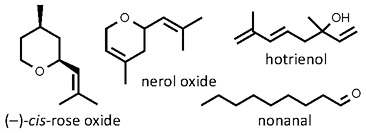 Sambucus nigra
Sambucus nigra
elderflowers • elderberries
Back to “Spices: elder flowers (Sambucus nigra)fl; elderberries (Sambucus nigra)fr”
Sambucus nigra L. (Caprifoliaceae); vlier (Afrikaans); sureau (French); Schwarzer Holunder (German); sambuco (Italian); sabugueiro (Portuguese); saúco, sabuco (Spanish)
DESCRIPTION Elderflowers comprise the small white corollas (five fused petals with five attached stamens) that become dislodged from the flower heads when they are dried. The flowers have an aromatic, musky smell.
THE PLANT Elder is a shrub or small tree (up to 6 m or 20 ft) with compound leaves and small white flowers borne in flat-topped cymes. The fruits (elderberries) are three-seeded drupes (edible only when ripe and preferably cooked). American elder (S. canadensis), from the eastern parts of North America, is sometimes considered to be a subspecies of S. nigra.1
ORIGIN Indigenous to North Africa, Europe and Asia.1 There are many superstitions and myths associated with elder.1,2 There is renewed interest in elder as a crop.
CULTIVATION Selected cultivars of both species are grown in plantations, mainly in Europe, Canada and the United States, for the production of flowers and berries. Trees grow well in almost any soil (including chalky soil)2 and prefer full sun. Propagation is from seeds or semi-hardwood cuttings taken in summer.2
HARVESTING Flowers and berries are wild-harvested or collected from commercial plantations. The inflorescences are picked on a dry, sunny day (to preserve the pollen)2 and are carefully placed upside down to dry so that the flowers can be collected. The fruits are picked when black and fully ripe.
CULINARY USES The aromatic flowers are traditionally soaked in sugar water to make elderflower cordial, fermented to make elderflower wine (which can be still or sparkling) or distilled for alcoholic drinks (such as Italian sambuca and Swedish fläderblomsnaps)2,3. Flowers are also mixed into a light batter of eggs and flour and fried to make elderflower fritters.3 Ripe elderberries, with seeds removed, are turned into elderberry wine, vinegar and chutney.3 They are added to jams, jellies, apple pies (and in Portugal, port wine) to improve the colour and flavour. Pontack sauce3, made from elderberries, vinegar and spices, is said to be named after a fashionable London tavern called “Pontack’s Head”, opened in 1666 by François-Auguste de Pontac, an eminent French cook and winemaker.
FLAVOUR COMPOUNDS The aroma of elderflowers is caused by an extremely complex mixture of volatile compounds.4 The typical musky aroma of the flowers was found to be associated with a few major aroma-impact compounds, which included (–)-cis-rose oxide, nerol oxide, hotrienol and nonanal. However, the floral fragrance was found to be caused by linalool, α-terpineol, 4-methyl-3-penten-2-one, and (Z)-β-ocimene, and fruity odours by pentanal, heptanal, and β-damascenone. The presence of hexanal, hexanol, and (Z)-3-hexenol accounted for the fresh and grassy odours also associated with elderflowers and elderflower cordial.4

NOTES The pith of old stems are used to hold small botanical specimens for hand sectioning when doing anatomical studies.
1. Mabberley, D.J. 2008. Mabberley’s plant-book (3rd ed.). Cambridge University Press, Cambridge.
2. McVicar, J. 2007. Jekka’s complete herb book. Kyle Cathie Limited, London.
3. Vaughan, J.G., Geissler, C.A. 1997. The New Oxford book of food plants. Oxford University Press, Oxford.
4. Jørgensen, U., Hansen, M., Christensen, L.P., Jensen, K., Kaack, K. 2000. Olfactory and quantitative analysis of aroma compounds in elder flower (Sambucus nigra L.) drink processed from five cultivars. Journal of Agricultural and Food Chemistry 48: 2376−2383.